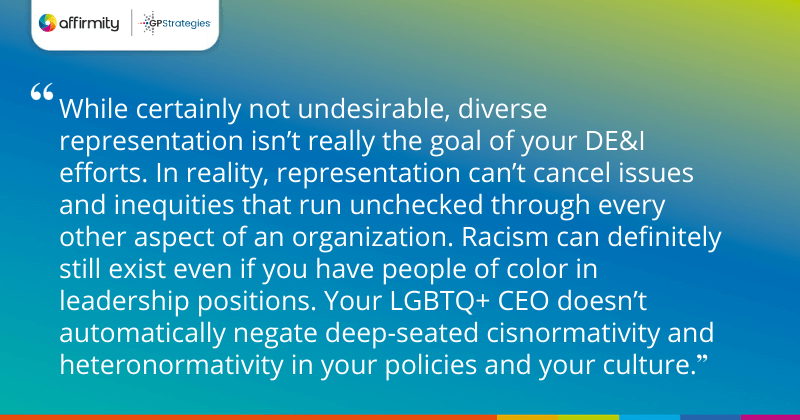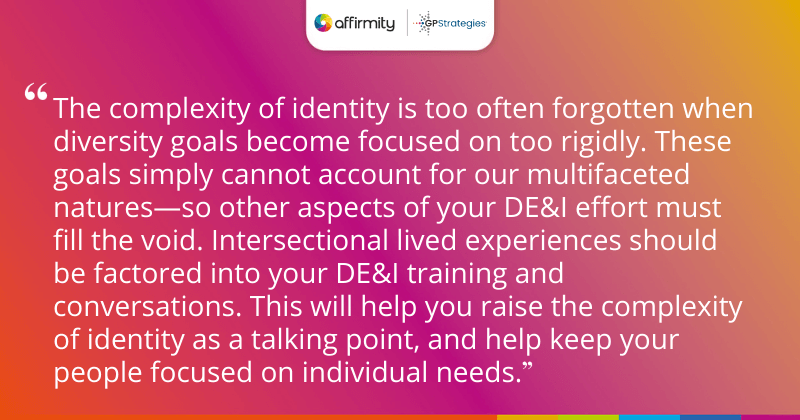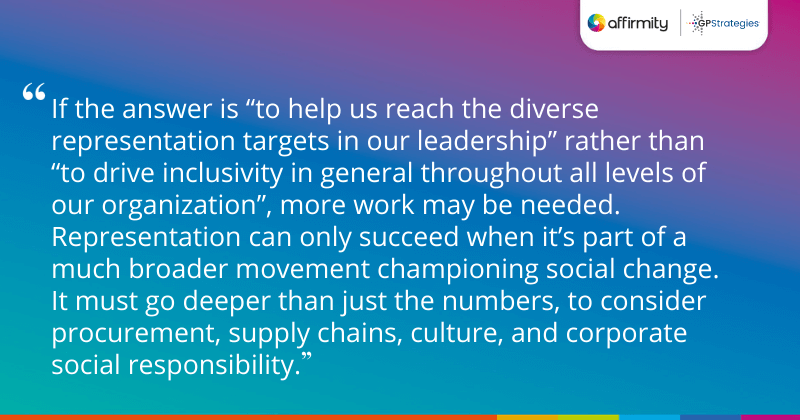So you’ve finally done it—50% of your leadership are women and you have an LGBTQ+ CEO. You’ve finally crossed the finish line for diversity, equity and inclusion… right? In this article, Alice MacDonald, a consultant at PDT Global (part of Affirmity), examines why having representation across all levels alone won’t create long-term, sustainable change and shouldn’t be the end-goal of your DE&I efforts.
While certainly not undesirable, diverse representation isn’t really the goal of your DE&I efforts. In reality, representation can’t cancel issues and inequities that run unchecked through every other aspect of an organization. Racism can definitely still exist even if you have people of color in leadership positions. Your LGBTQ+ CEO doesn’t automatically negate deep-seated cisnormativity and heteronormativity in your policies and your culture.

1) Beyond Diversity
This isn’t to say that diverse representation isn’t a useful stepping stone. Equitable opportunities within an organization are ethically vital, and a diversity of perspectives may help you more easily recognize where you have issues and where non-inclusive practices have gone unnoticed. Figures above you in the organization can also be inspirational and can reassure you that you too could climb the ladder.
However, to treat this representation as more than a positive step can do more harm than good. Yes, diversity targets are important, but identity is more complex than such targets account for. Organizations can fall into the trap of giving themselves a ‘gold star’ for their efforts, after which that one moment of effort becomes a distracting façade. Inequality goes uninvestigated because the attitude becomes “we’re good on this already, didn’t we solve that?”
In fact, if your people are still looking exclusively at gains in senior-level diversity in this way, it’s more a sign of all the work still left to do than it is a sign of advanced progress. It’s arguably a symptom of a space where some are elevated while the majority are struggling—by definition, inequality. DE&I work should operate to disrupt systems that create norms and advantages over others.
HAND-PICKED FOR YOU | ‘Why Workplace Diversity Continues to Stagnate Without Accountability and Measurement’

2) Beyond Categories
And then, there’s intersectionality—the elephant in the room of all discussions about workplace diversity data. Say you’re a bit more advanced than just being able to point to your LGBTQ+ CEO. Perhaps you’ve got a thriving LGBTQ+ network that’s really active and pushing for policy changes in your workplace. That may still only be the beginning—are queer women specifically well represented? What about LGBTQ+ people of color?
The complexity of identity is too often forgotten when diversity goals become focused on too rigidly. These goals simply cannot account for our multifaceted natures—so other aspects of your DE&I effort must fill the void. Intersectional lived experiences should be factored into your DE&I training and conversations. This will help you raise the complexity of identity as a talking point, and help keep your people focused on individual needs.
McKinsey’s ‘Women in the Workplace 2021’ report found that while women’s representation increased across all levels of the corporate pipeline in 2020 (despite the pandemic), women of color specifically continue to lose ground at every step along it. The research also noted that, although three-quarters of white employees consider themselves allies to women of color, less than half can back that claim up with basic actions such as advocating for new opportunities for this group, or speaking out against bias shown towards them.
FURTHER THOUGHTS ON ALLYSHIP | ‘3 Key Ways to Build a Culturally-Aware Climate in Your Organization’

3) Beyond Business
In practice, limiting your focus to single ‘identity strands’ such as “increasing women in our leadership” leaves anyone who falls between groups at risk of falling through the cracks. It is therefore essential that you take as wide a view as possible when considering diversity, and that you bring inclusion and allyship into the conversation.
Going forward, anyone drawing up DE&I training plans needs to ask themselves: why am I doing this? And if the answer is “to help us reach the diverse representation targets in our leadership” rather than “to drive inclusivity in general throughout all levels of our organization”, more work may be needed. Representation can only succeed when it’s part of a much broader movement championing social change. It must go deeper than just the numbers, to consider procurement, supply chains, culture, and corporate social responsibility.
If that sounds like a never-ending DE&I workload, you’re not wrong—but that’s exactly the point. Creating true workplace equity is as large and pressing a task as creating a more equitable society. We have a long way to go to create both, and both really need to go hand in hand.
MORE ON THE IMPORTANCE OF INCLUSION | ‘Why Safeguarding Inclusion Is the Key to Riding Out the Great Resignation’
If you would like to discuss how to become a more diverse, inclusive, and equitable organization, please contact us today.
A version of this article was previously published in trainingjournal.com.
